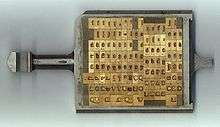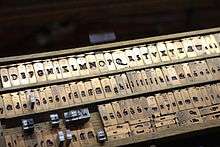Matrix (printing)

In hot metal typesetting, a matrix is a mold for casting a letter, known as a sort, used in letterpress printing.[6] However, in printmaking the matrix is whatever is used, with ink, to hold the image that makes up the print, whether a plate in etching and engraving or a woodblock in woodcut.
Description
In letterpress typography the matrix of one letter is inserted into the bottom of a hand mould, the mould is locked and molten type metal is poured into a straight-sided vertical cavity above the matrix. When the metal has cooled and solidified the mould is unlocked and the newly cast metal sort is removed, ready for composition with other sorts. The matrix can then be reused to produce more copies of the sort.[7] The matrix will be made by driving a punch of the type to be made into soft copper, or electrotyping a matrix from a piece of type.
In continuous casting and composition casting typography, the matrix or mats for a complete font are loaded into a matrix-case and inserted into a casting machine, which casts the required sorts for a page composition automatically.
See also
References
- ↑ "Jannon". French Ministry of Culture.
- ↑ "Monotype Garamond". Fonts.com. Monotype. Retrieved 4 July 2015.
- ↑ "Garamond". Microsoft. Retrieved 4 July 2015.
- ↑ "Monotype matrices and moulds in the making" (PDF). Monotype Recorder. 40 (3). 1956.
- ↑ Morison, Stanley. "Printing the Times". Eye. Retrieved 28 July 2015.
- ↑ Man, John The Gutenberg Revolution:The story of a genius that changed the world © 2002 Headline Book Publishing, a division of Hodder Headline, London. ISBN 0-7472-4504-5. A detailed examination of Gutenberg's life and invention interwoven with the underlying social and religious upheaval of Medieval Europe on the eve of the Renaissance.
- ↑ Meggs, Philip B. A History of Graphic Design. John Wiley & Sons, Inc. 1998. (pp 58–69) ISBN 0-471-29198-6

